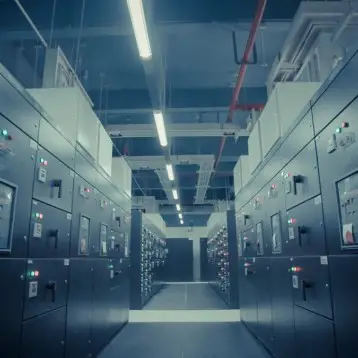Seagate and AIC
|
Seagate unveiled the latest addition to the “Cheetah” hard disk drives series. The 15K.6 Model, which is just about to hit the market, is available in 145GB, 300GB or 450GB capacities, and reaches transfer rates of 164 MB/s. The 3.5-inch, 15,000RPM drives are equipped with 16MB of cache, have an estimated 1.6 million hours of “mean time before failure” (MTBF), and according to the company, consume 39% less power than the preceding models. The dramatic power consumption decrease was achieved thanks to the built-in “Seagate PowerTrim” technology. The technology allows for dynamic power consumption optimization by supplying power according to the system’s state of activity– either idle or active. The drives come in the Serial Attached SCSI (SAS) version and are aimed primarily at the server market. The American “Super Micro Computer” Company has already announced it will be utilizing the 15K.6 series into its SuperServers.
Seagate also held a joint live demonstration with the U.S. Company “AIC”, which introduced its new MAX I/O technology and showcased the latest products from its SAS line. MAX I/O was designed to utilize PCI Express “directly at the source” – Intel’s MCH (memory controller hub), eliminating the need for expensive switches. Users can select their desired level of I/O expansion and actively manage the PCI Express lanes – either individually or grouped. The two companies demonstrated AIC’s SAS/SATA JBOD subsystems, which worked with Seagate’s Cheetah, Savvio, and Barracuda drives.
SanDisk
|
One of the leaders of the storage industry, SanDisk showcased a range of 64GB SSD’s with a 67 MB/sec reading speed. One of the more interesting products presented by SanDisk was the “Vaulter Disk”, a small 8GB/16GB flash-based drive. According to the company, the Vaulter Disk can be used to separately run all OS-related work and store frequently accessed files, while the hard disk drive itself remains 100% dedicated to user-driven applications.
|
Additionally, the company unveiled its new “FlashBack” adaptor – a notebook-dedicated “ExpressCard” backup solution, which automatically backs up your mobile content to a memory card. Any time data is altered in any file or folder that was pre-selected by the user, the latest version is immediately updated on the card or even online, allowing the user to access the backed-up data from any other PC. FlashBack is expected to hit the market towards the middle of 2008, at an estimated price of $30.
Iomega
Iomega launched its REV 120GB Backup Drive, which is equipped with a USB 2.0 (for external use) and SATA interfaces (for internal use). REV removable hard disks are divided into two parts – the drive bay, which stores sensitive read-write heads and electronics, and a completely isolated low-cost removable disk, which hosts the platter and a fluid-dynamic bearing motor. The company says the biggest advantage of such unique design is speed, because the disks allow users to backup and restore data up to 10 times faster than tape drives. Additionally, a REV disk requires zero maintenance – it is sealed against contamination and integrates a virtual clean room environment. This is supported by automatic head-cleaning, air filtration, and two-stage error correction for automatic data verification.
|
According to Iomega, the new drive reaches transfer rates of up to 35 MB/sec and has an estimated 30-year archival life, with approximately 1 million rewrite durability. This model will become available around April, and its ATAPI-interface counterpart will hit the market towards mid 2008. “The new REV 120GB Backup Drive offers more native capacity, near instantaneous random access to files, faster backups and restores, and ‘ruggedized’ cartridges — all at a much better drive price” – said Tom Kampfer, President and CEO of Iomega Corporation.
Samsung
Samsung announced the shipment of its newly developed 2.5’’ 500GB hard disk drive for laptop computers. The disk consists of three 167GB platters. The company says two such disks can fit into most notebook computers, providing an impressive 1TB storage capacity. Other specifications include a 5,800rpm spin rate, an 8MB cache, and a 3GBps SATA interface. This product is already available for purchase in the U.S. at a price of $300.
“Our customers require more and more notebook storage for their data, video, and music files,” said Andy Higginbotham, Director of Hard Drive Sales and Marketing, Samsung Semiconductor. “Our Spinpoint M6 easily fits within notebook PCs with no modification to the notebook PC chassis, giving users more storage power than ever before.”
|
As for Flash SSDs, Samsung presented a 64GB model, and it seems a 128GB model will be released towards mid 2008. The really good news – Samsung plans to release a 250GB Flash SSD model by the end of this year.
OCZ also unveiled SSD drives, which will be available in both 32GB and 64GB capacities. Patriot showcased one of the more impressive SSDs, with a 128GB capacity. The company also presented waterproof “Xporter XT” 32GB/64GB USB thumb drives, and announced it will be shipping them towards the middle of this year.
Corsair
Shortly before CeBIT, Corsair unveiled its 32GB USB thumb drive. At the show, the company showcased the new 16GB USB 2.0 “Voyager GT” flash drive model, with transfer rates 4 times higher than those of mainstream USB 2.0 thumb drives. Does anyone need to transfer a 1.5GB movie in under 2 minutes? The new drive is equipped with AES 256-bit encryption software, selected NAND flash chips, and “state-of-the-art” controller technology. It also sports a water and shock-resistant case, and is up for grabs at a price of $170.
Cool Cooling Systems from Gigabyte
|
Gigabyte’s “Cool Rain” System may look like a Sci-Fi stapler, but in fact, it is a unique memory cooling device. Cool Rain supports dual-channel memory, includes a flip-open radiator with a 5cm fan, two heat spreaders, a tiny pump and water container, and an impressive blue LED. According to the company, the product, which received a lot of attention from fair-goers, is scheduled to hit the market in a little less than six months’ time.
Gigabyte also showcased its “Roll-Pad”, which is a roll-up aluminum pad that effectively draws the heat away from the bottom of the notebook PC. This patented notebook cooler, which was awarded this year’s ‘Product Design Award’, is now available for purchase for approximately $50.
Open-E
The German company Open-E launched three update features to their Data Storage Server (DSS) product line, currently in its fourth generation. Users can set the software so that it will automatically switch over to a secondary storage server in case of a failure or scheduled maintenance of the primary storage server. The software is also equipped with the “Write-Once, Read-Many” (WORM) technology, which allows information to be written onto a particular disk only once, but to be read multiple times without being subject to erasures or modifications. According to the company, this archiving feature has special appeal to large institutions concerned about inadvertent loss of data. Another feature that was added to the new DSS line is the Network Data Management Protocol (NDMP) used to “control data backup and recovery communications between primary and secondary storage in heterogeneous network environments”.
Adaptec
The American “Adaptec” Company launched its “Series 5” RAID controllers“. The RAID controllers offer 28-port connectivity and allow up to 256 SATA or SAS drives to be connected to a single system, providing approximately 200TB of storage capacity. According to the company, the new x8 PCI Express controllers are five times faster than those sold by their competitors, reaching speeds of 250,000 I/Os per second and throughput rates of up to 1.2 GB/sec. “These efficient new PCIe interface controllers are designed for a wide range of storage-critical, bandwidth-intensive applications, such as Web hosting, digital video surveillance, medical imaging, and communications” – states the company. All of these newly launched products are already available on the market, their prices ranging from $425 to $1,595.
Memory
|
The fastest memory on the market was showcased by Corsair. The company displayed the DDR3-2133MHz memory modules, which have a 1GB capacity and are capable of performing at latencies of 8-8-8-24. These “Dominator” modules are integrated with the company’s unique Dual-path Heat eXchange (DHX) technology. The DHX utilizes two paths for heat removal – an aluminum heat spreader, and a special PCB, which has a copper base that absorbs heat transferred by a dedicated heat sink. According to the company, the DHX modules, each of which includes a total of four heat sinks, provide an extremely stable, reliable, and overclockable memory.
OCZ Technology was one of the most impressive exhibitors at CeBIT this year. The company unveiled high-speed DDR3 memory modules capable of running at speeds as high as 2100MHz, at a relatively low voltage rate of 1.9V. These enthusiast-oriented modules come with OCZ’s “Flex2” cooling system, which employs dedicated liquid channels over the chips themselves. According to the company, the Flex2 system ensures stability and high performance in an overclocked state.
Patriot showcased the latest memory modules of their “Viper” series, 2GB DDR3 modules that can run at 2000MHz with latencies of 8-8-8-20. These modules operate at a relatively high voltage of 2.15V, but the company is not concerned, saying the modules were specifically designed and tested to withstand extreme operating environments. Patriot also demonstrated its new active two fan cooling system, designed to further boost their products’ overclocking capabilities.
TFOT previously covered a number of innovative storage solutions. Check out our detailed coverage of SanDisk’s “Vaulter Disk”, which was showcased at the 2008 Cebit show. TFOT also covered a novel nanoscale technology for memory storage, which was developed at the Center for Applied Nanoionics (CANi) at Arizona State University. This technology promises to deliver higher performance, increased capacity, and longer battery life to the consumer electronics industry. You can also read an article about a newly developed ultra-fast technology for laser-based all-optical magnetic hard disk drives, developed by a team of researchers from the Netherlands and Japan. For more information, read TFOT’s full coverage of this year’s Consumer Electronics Show in Las-Vegas, where many state-of-the-art storage solutions were presented.

















